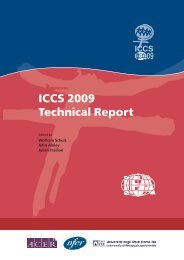Teacher Education and Development Study in Mathematics - IEA
Teacher Education and Development Study in Mathematics - IEA
Teacher Education and Development Study in Mathematics - IEA
You also want an ePaper? Increase the reach of your titles
YUMPU automatically turns print PDFs into web optimized ePapers that Google loves.
126<br />
TEACHER PAY AND STUDENT MATHEMATICS ACHIEVEMENT<br />
Norway<br />
Composition of the teacher labor force<br />
Nearly 73% of the teach<strong>in</strong>g force at the primary <strong>and</strong> the lower-secondary levels of the<br />
education system are female. This proportion changes at the upper-secondary level,<br />
where the percentage of male teachers—at least of full-time teachers—is higher than<br />
that of female.<br />
There is a general shortage of qualified teachers <strong>in</strong> mathematics, English, <strong>and</strong> Norwegian<br />
at the compulsory school level. While there is also some shortage <strong>in</strong> the natural sciences,<br />
the impact of this is felt ma<strong>in</strong>ly at the upper-secondary level. Regional shortages of<br />
teachers also exist, especially <strong>in</strong> the three northern-most counties of the country. The<br />
age structure of the teach<strong>in</strong>g profession is skewed toward people near<strong>in</strong>g retirement, so<br />
there is concern that the supply of teachers will not be able to keep pace with dem<strong>and</strong><br />
(Lyng & Blichfeldt, 2003). The problem of ag<strong>in</strong>g teachers is more acute <strong>in</strong> uppersecondary<br />
schools, where approximately 50% of the teach<strong>in</strong>g force is 50 years of age<br />
<strong>and</strong> over. The correspond<strong>in</strong>g figure at the compulsory school level is 36.5%.<br />
Not all qualified teachers choose to teach, <strong>and</strong> this is a problem, especially at the uppersecondary<br />
level. Only 67% of those teachers with extensive post-secondary-school study<br />
(at least five to six years at university) enter the teach<strong>in</strong>g profession. <strong>Teacher</strong>s with this<br />
level of qualification are particularly attractive to other professions, which makes their<br />
decision to choose or not choose teach<strong>in</strong>g sensitive to changes <strong>in</strong> the labor market (Lyng<br />
& Blichfeldt, 2003). Sensitivity to labor market conditions is not seen at the compulsory<br />
school<strong>in</strong>g level, where there has been a steady <strong>in</strong>crease <strong>in</strong> the proportion of graduates<br />
from teachers’ colleges (four years of post-secondary education) who actually choose<br />
to teach.<br />
Nearly 90% of eligible teachers opted for early retirement <strong>in</strong> 2001/2002. This figure<br />
contrasts sharply with retirement figures for other public-sector professionals. A large<br />
percentage of early teacher retirees (36.5%) are those who take up the option <strong>in</strong> their<br />
employment contracts that allows for early retirement at age 62. Research <strong>in</strong> this area is<br />
limited, but exist<strong>in</strong>g studies suggest that a significant percentage of teachers who leave<br />
the profession do so because of better labor market opportunities (Lyng & Blichfeldt,<br />
2003).<br />
There was a net outflow of teachers 45 years of age <strong>and</strong> over <strong>in</strong> 2006, <strong>and</strong> a considerable<br />
<strong>in</strong>crease <strong>in</strong> early retirement between 2001 <strong>and</strong> 2006. The average early retirement age <strong>in</strong><br />
schools is 63 years, <strong>and</strong> those who leave at this time do so with a full pension. However,<br />
teachers are stay<strong>in</strong>g longer <strong>in</strong> their jobs than previously. The mean age of retirement<br />
among all employed <strong>in</strong> schools <strong>in</strong>creased from 57 years <strong>in</strong> 2001 to 60 <strong>in</strong> 2006, <strong>and</strong><br />
health-related early retirement dropped between 2001 <strong>and</strong> 2006.<br />
In 2006, approximately 11,000, or about 20%, of employed teachers were work<strong>in</strong>g<br />
<strong>in</strong> sectors other than schools (or k<strong>in</strong>dergartens). Among new teacher graduates <strong>in</strong><br />
1999, 92% had found employment with<strong>in</strong> six months of graduat<strong>in</strong>g (Arnesen, 2002).<br />
Of this group, only 7.6% were work<strong>in</strong>g outside the school sector. As we noted above,<br />
the extent to which teachers move out of the teach<strong>in</strong>g profession <strong>and</strong> <strong>in</strong>to other<br />
occupations is affected by labor-market conditions. A recent <strong>and</strong> unpublished study by<br />
three Norwegian economists shows that a reduction <strong>in</strong> unemployment <strong>in</strong> local labor<br />
markets tends to reduce the availability of qualified teachers (M<strong>in</strong>istry of <strong>Education</strong><br />
<strong>and</strong> Research, 2009).

















